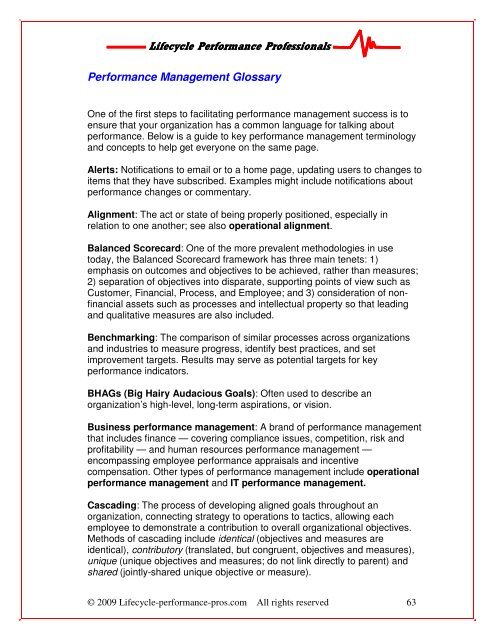Download the Performance Management Fundamentals Guide
Download the Performance Management Fundamentals Guide
Download the Performance Management Fundamentals Guide
Create successful ePaper yourself
Turn your PDF publications into a flip-book with our unique Google optimized e-Paper software.
Lifecycle Lifecycle <strong>Performance</strong> <strong>Performance</strong> Professionals<br />
Professionals<br />
<strong>Performance</strong> <strong>Management</strong> Glossary<br />
One of <strong>the</strong> first steps to facilitating performance management success is to<br />
ensure that your organization has a common language for talking about<br />
performance. Below is a guide to key performance management terminology<br />
and concepts to help get everyone on <strong>the</strong> same page.<br />
Alerts: Notifications to email or to a home page, updating users to changes to<br />
items that <strong>the</strong>y have subscribed. Examples might include notifications about<br />
performance changes or commentary.<br />
Alignment: The act or state of being properly positioned, especially in<br />
relation to one ano<strong>the</strong>r; see also operational alignment.<br />
Balanced Scorecard: One of <strong>the</strong> more prevalent methodologies in use<br />
today, <strong>the</strong> Balanced Scorecard framework has three main tenets: 1)<br />
emphasis on outcomes and objectives to be achieved, ra<strong>the</strong>r than measures;<br />
2) separation of objectives into disparate, supporting points of view such as<br />
Customer, Financial, Process, and Employee; and 3) consideration of nonfinancial<br />
assets such as processes and intellectual property so that leading<br />
and qualitative measures are also included.<br />
Benchmarking: The comparison of similar processes across organizations<br />
and industries to measure progress, identify best practices, and set<br />
improvement targets. Results may serve as potential targets for key<br />
performance indicators.<br />
BHAGs (Big Hairy Audacious Goals): Often used to describe an<br />
organization’s high-level, long-term aspirations, or vision.<br />
Business performance management: A brand of performance management<br />
that includes finance — covering compliance issues, competition, risk and<br />
profitability — and human resources performance management —<br />
encompassing employee performance appraisals and incentive<br />
compensation. O<strong>the</strong>r types of performance management include operational<br />
performance management and IT performance management.<br />
Cascading: The process of developing aligned goals throughout an<br />
organization, connecting strategy to operations to tactics, allowing each<br />
employee to demonstrate a contribution to overall organizational objectives.<br />
Methods of cascading include identical (objectives and measures are<br />
identical), contributory (translated, but congruent, objectives and measures),<br />
unique (unique objectives and measures; do not link directly to parent) and<br />
shared (jointly-shared unique objective or measure).<br />
© 2009 Lifecycle-performance-pros.com All rights reserved 63










